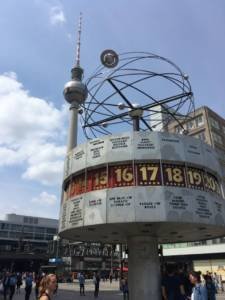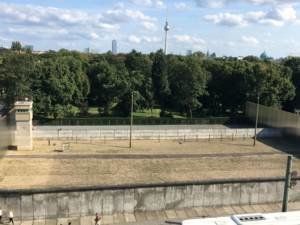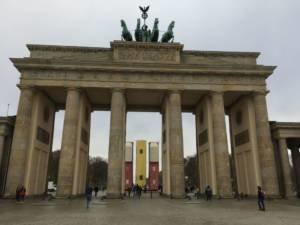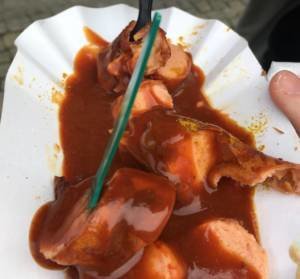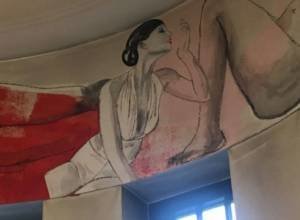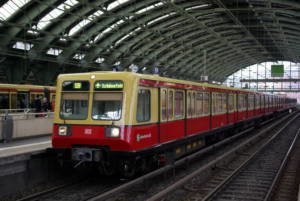Berlin was the capital of Prussia, the German Empire, Nazi Germany, the German Democratic Republic, before becoming the capital of Reunified Germany. Here, history is everywhere you turn. Spending a couple of days in Berlin will therefore give you only an overview of the city and its treasures. This 2-day itinerary focuses on the 20th century events that define the city today: WWII and the Cold War.

Day 1 : Getting to Know Berlin
Today involves a lot of walking, but tourists can also board Bus #100, from the Brandenburger Gate to Museumsinsel.
Brandenburger Tor is, of course, one of the iconic monuments of Berlin. Erected in the 18th century by the king William Frederic II, it became, during the Cold War, a symbol of the separation of Berlin. The Wall (1961-1989) stood just a few yards to the west of the gate. Notice the line of cobblestones running on the ground: this is where the Wall was, separating East and West Berlin for 27 years. Nowadays, the Gate and Pariser Platz are reserved to pedestrians and offer gorgeous perspectives on the two avenues, Unter den Linden and Straße des 17. Juni.
South of the Gate, the Memorial to the Murdered Jews of Europe (2004) is a chilling reminder of the Holocaust. Dark and severe, it successfully conveys feelings of claustrophobia and anxiety. Nearby memorials in Tiergarten honor other victims of National Socialism, most notably the Sinti and Roma peoples and homosexuals, and victims of the East German Regime.
The Reichstag Building is another important landmark. Seat of the German Parliament under the Empire and the Weimar Republic, it was destroyed by a fire in February 1933, under mysterious circumstances. To this day, no historian can prove whether the culprit was really Dutch Communist Marinus van der Lubbe, or if Goering and the SA orchestrated the entire operation. The fact remains that Hitler and the Nazis exploited the event to their advantage. The British architect, Sir Norman Foster, artfully combined the ruins into his modern and functional design. Germany’s Parliament has been meeting here since the renovation in 1999. To visit the glass dome or for a guided tour, make an online reservation.
This avenue, prominently used under the East German Regime to showcase its power, is one mile long. Old-looking buildings, either renovated or completely rebuilt, are mostly located in the eastern part of the boulevard.
In 1933, the Nazis burned many books in 1933 here on Bebelplatz. In the middle of the square, the Sunken Library Memorial (1995, installation by Israeli artist Micha Ullman) is a window looking below the ground into an empty library.
Prussian kings created several museums to display their collections, on Museumsinsel. The newest building site is dedicated to the reconstruction of the Castle of Berlin, almost a replica of the 18th century original destroyed during WWII.
To Checkpoint Charlie (1 mile)
Retrace your steps to Margrafenstraße, and turn south. Very soon, Gendarmenmarkt appears in front of you: an elegant square adorned with two identical churches and a concert hall. All three were heavily damaged during WWII and renovated.
Follow Friedrichstraße to Checkpoint Charlie.
Checkpoint Charlie was, of course, one of the main crossing points between East and West Berlin during the Cold War. Here, a guard house and several museums commemorate the division of the city.
Day 2: Exploring More of Berlin
Today focuses on East Berlin and the Cold War. It involves some walking but less than day 1, and some public transportation. Start on the Ost Bahnhof side, and walk along the murals in the direction of the Oberbaum Bridge.
East Side Gallery is the longest stretch of the Berlin Wall still standing (almost one mile long). In 1990, muralists from all over the world documented their impressions of the Fall of the Wall, the hardships under the Communist Regime and their hopes for a better world. Unfortunately artworks have been damaged and vandalised over the years. Some artists renovated their own mural, hence the two dates on the mural (1990, 2009).
Built out of bricks in the late 19th century, Oberbaum Bridge was another crossing point between East and West during the Cold War. The River Spree used to be the border; the Wall stood where the East Side Gallery is now located. As the bridge wasn’t used for traffic, it fell into disrepair. Rebuilt and restored after Reunification, it needed a new middle section, created in steel by Spanish architect Santiago Calatrava (1996). From the bridge, looking toward the East, one gets a good view of the massive Molecule Man, installed in the middle of the river by American artist Jonathan Borofsky.
Take the streetcar M10 to Bernauerstraße (35 minutes) to Mauer Park. It used to be part of the Death Strip and there is still a section of the Wall standing here. On Sundays, locals and tourists gather at the park for the colorful flea market.
Incidentally, streetcars are only found in the former East Berlin.
Walk back to Bernauer Staße and cross it. You will follow the Wall Memorial, dotted with stories about Berliners who tried to escape the East German Regime. In the first few days, people jumped from the buildings near the wall, later others dug tunnels. Berliner Unterwelten provides guided tours of some tunnels. Several archaeological sites display the foundations of the structures between the Wall (in fact two walls) and the Death Strip. The Chapel of Reconciliation, an oval mud-brick structure, protected by wooden pillars, and the rye field surrounding it, offers a meditative space to reflect on the horrors committed here, and elsewhere. It replaces the old chapel, destroyed in 1985 by the Communist regime.
Across the street, the Documentation Center has a small exhibit with accounts and photos. The terrasse at the top of the center provides a good view into the section of the Death Strip that has been preserved. At the end of the Memorial, a 3D-map of this section of the Berlin Wall recreates the area and helps get a better understanding of the difficulties encountered by those who wanted to leave.
To Alexanderplatz
Take the M10 back to Brunnenstraße U-Bahn, then the U8 to Alexanderplatz (15 minutes)
The TV Tower (1969), or Fernsehturm, is the most impressive building in Alexanderplatz and the third symbol of Berlin. Of course, it used to be an emblem representing the greatness of Communism until 1989. At 1200 feet, it is still the tallest freestanding structure in Germany. There is an observation deck and a rotating restaurant in the sphere. Make reservations to enjoy the Berlin scenery from above.
Food and Drink
While wandering in the center of Berlin, tourists realize that many restaurants offer foreign dishes, perhaps most notably Italian, Greek, and various Asian food.
On the Go
Despite their exotic names, Döner Kebab (or Kebap) and Currywurst are true Berliner fast-food options. Find them in small shops called Imbiss.
First, the Döner Kebab. Originally Turkish, this style of cooking meat (chicken, beef, veal or lamb) on a vertical rotisserie is extremely popular here. Choose your style of wrap, usually pita, lavash, dürüm bread or Turkish pizza. Add lettuce, fresh vegetables such as tomato and cucumber, and a sauce (spicy or garlic). Kebab shops also offer vegetarian options based on falafel and fried vegetables.
Health Concerns: German law mandates that the meat must be sold the same day it is cooked, therefore ensuring a safe product. However, expect the fat content of your sandwich to be quite high.
Second, the Currywurst, a real Berlin creation. A pork sausage, or Bratwurst, cut into pieces and topped with a curry-ketchup sauce is the base of the dish. Order it with French fries or in a brötchen (bread). Konnopke’s Imbiss, under the arcades of the U-Bahn viaduc near Eberswalder Station, is one of the oldest and most famous Currywurst joint.
By the way, if this dish becomes your new favorite fast-food, you should visit the Currywurst Museum, near Checkpoint Charlie.
Typical German Restaurants or Deutsche Küche
Restaurant zur Gerichtslaube offers traditional Berlin cuisine, in a 13th-century Gothic brick building. Guests eat in medieval rooms with vaulted ceilings. In addition to the regular menu, the chef proposes a “seasonal menu”, incorporating fresh vegetables and fruits. After the meal, enjoy a walk around the old buildings of the picturesque Nikolaiviertel.
Lutter und Wegner am Gendarmenmarkt is another restaurant with a historical background. Actors, singers and artists used to come here during the 1920s and 1930s. The sophisticated decoration, lamp fixtures, and paintings in the dining rooms recreate the fashionable atmosphere the eatery must have had before WWII. This restaurant has another location on Potsdamer Platz.
This 2-day Berlin escapade is only a quick introduction to a city that has a lot to offer: unique artwork in world-class museums, magnificent castles at Charlottenburg and Potsdam, street art everywhere, and more.
If you have time, consider a cruise on the Spree River: commentaries in English will help you identify all the monuments. The Museum Story of Berlin presents the 800-year history of the city, including WWII and cold war events.
Don’t wait too long to come back!


